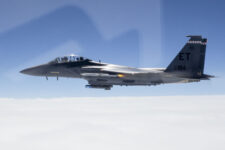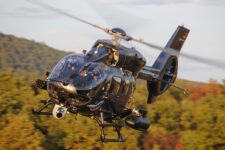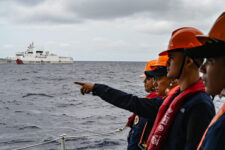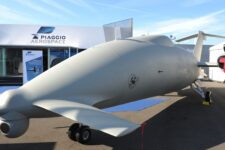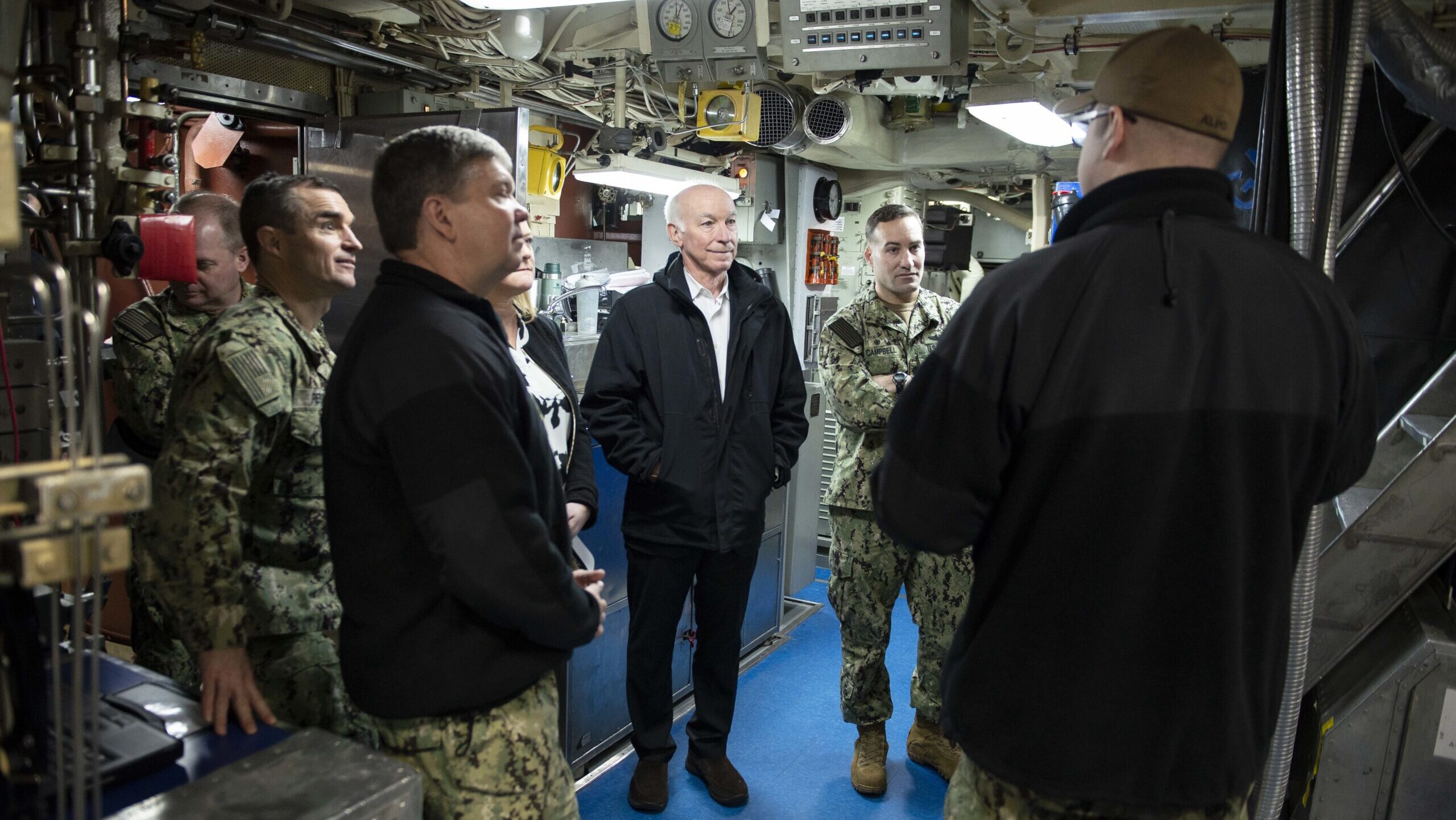
Rep. Joe Courtney, D-Conn., speaks with gold crew sailors during a familiarization tour aboard USS Kentucky (SSBN 737). Courtney is one of the most vocal AUKUS supporters in Congress. (US Navy photo by Mass Communication Specialist 1st Class Andrea Perez/Released)
Updated 10/25/2023 at 5:14 pm ET with comments from Mara Karlin.
WASHINGTON — As Australian Prime Minister Anthony Albanese meets with President Joe Biden at the White House today, several senior US Navy officials are making their case to lawmakers about why they need four “critical” legislative proposals surrounding the AUKUS security pact included in the next defense policy bill.
The visit by Albanese will feature discussions on a commercial space launch agreement as well as new subsea cable infrastructure aimed at assisting several Pacific islands, and conclude with a state dinner tonight. Administration officials told reporters ahead of the visit that AUKUS would only be talked about at a surface level given the detailed rollout that Biden, Albanese and British Prime Minister Rishi Sunak held in March. The administration officials added that more detailed announcements about AUKUS’s progression are expected to come by the end of the year.
But on Capitol Hill, Navy Under Secretary Erik Raven; Vice Adm. William Houston, commander of naval submarine forces; Rear Adm. Jonathan Rucker, program executive officer for attack submarines; as well as Mara Karlin, who is performing the duties of deputy under secretary of defense for policy, are testifying before the House Armed Services subcommittee on Seapower and Projection Forces about the submarine industrial base and the Pentagon’s role in bringing AUKUS to fruition.
Read more of Breaking Defense’s coverage of AUKUS.
In written testimony, the Navy officials laid out four “critical” legislative proposals the administration has sent to lawmakers, and are seeking inclusion in the Fiscal Year 2024 National Defense Authorization Act. The state of play for each provision varies from committee to committee, but virtually all legislation on the Hill has been paralyzed since former Speaker Kevin McCarthy was ousted from his position earlier this month. Republicans today elected Rep. Mike Johnson, R-La., to be the next speaker shortly before the AUKUS hearing began.
“Congress is a critical AUKUS partner. AUKUS can only succeed with the same, continued bi-partisan support demonstrated since the March 2023 announcement of the optimal pathway,” the Navy officials said in written testimony.
“To maintain momentum and programmatic schedules, there are four critical legislative proposals that must be passed as part of the FY 2024 National Defense Authorization Act,” the testimony continued.
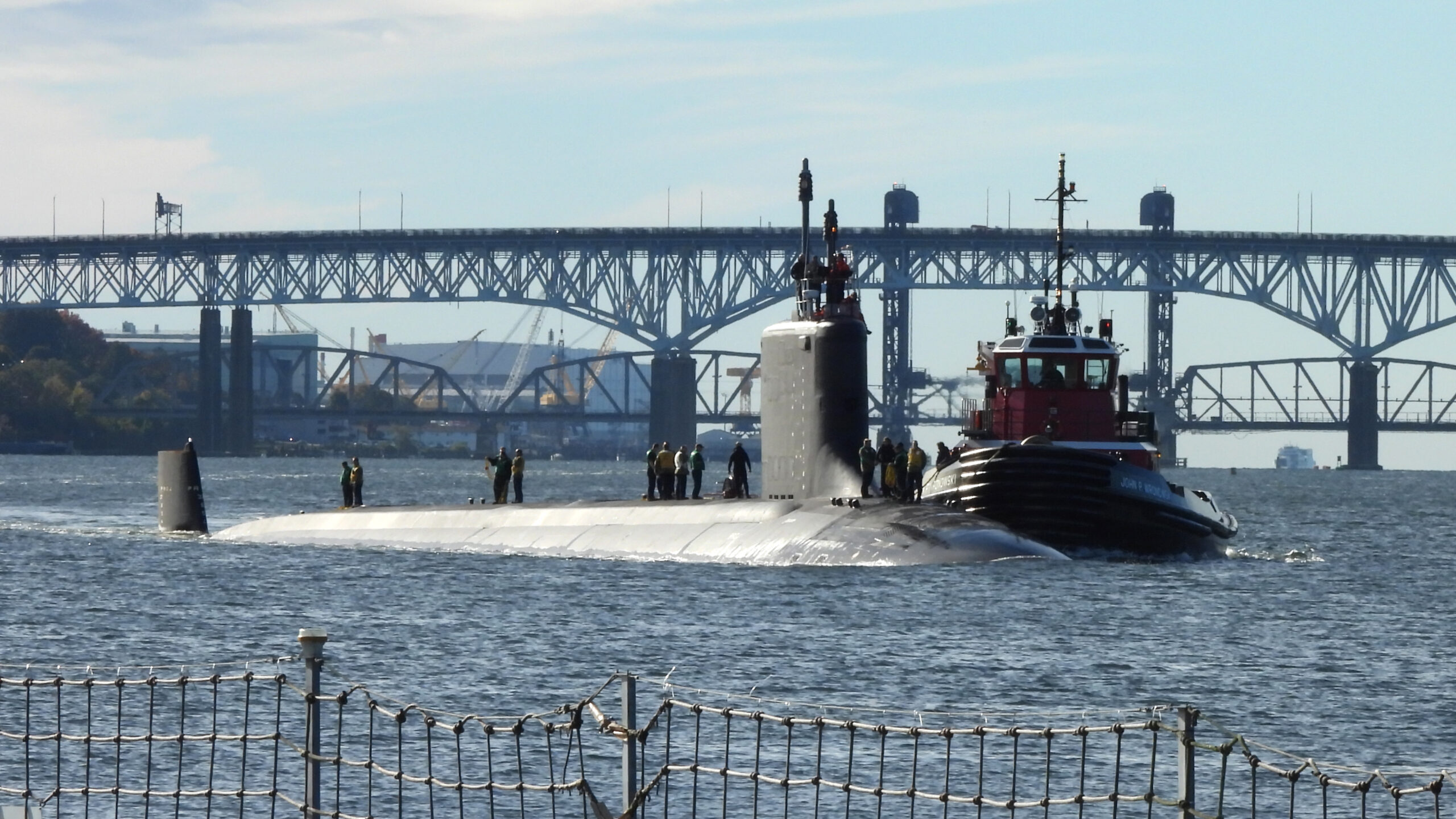
The Oregon (SSN-793) transits the Thames River after returning from routine operations in route to Naval Submarine Base New London in Groton, Conn. (US Navy photo by Petty Officer 2nd Class Wesley Towner)
The Asks: Sub Sales, Industry, Training, ITAR
The first proposal focuses on allowing the sale of three — or potentially five — Virginia class submarines, one of the centerpieces of the security pact and necessary to provide an interim capability to Australia because the country is not expected to have its own operational, nuclear-powered boat until closer to 2040.
“It is critical that this legislation pass without language that could undermine Australian certainty of these U.S. transfers under the agreed upon optimal pathway,” according to the testimony.
The “optimal pathway” refers to the three-pronged plan that Biden, Albanese and Sunak rolled out in March that both delivers submarines to Australia and facilitates a number of other technology transfers and industrial base investments.
The leaders were vague on when precisely that transaction might take place, estimating some time in the early 2030s. But both administration and Pentagon officials have emphasized Australia will make the final call on when to pull the trigger, and the American government will be ready when that time comes. Despite the time gap, the Navy officials say passing the legislation now is necessary because the associated foreign military sales case will be “extremely complicated” and Australian personnel will have their own planning work to do prior to the first submarine transfer.
“Including [Australia] in these efforts allows future [Australian] crews better access and understanding of the [submarine’s] operation and integrates the maintenance team for observation of the planning and execution of a large maintenance period,” according to the testimony.
The second legislative proposal is centered around the financial investment Australia is expected to make in the United States’ submarine industrial base to help it brace for the workload of producing submarines for the US Navy’s fleet while also assisting with any work that stems from AUKUS.
Australian Navy officials have previously said the country would invest up to $3 billion into the American industrial base as part of AUKUS.
The US Navy officials in their testimony today did not specify how much money Australia would invest, but said the funding is expected to begin flowing in 2025, and the Pentagon needs lawmakers to make appropriate adjustments in law to allow for those transactions to occur.
“In addition to paying replacement cost for each [Virginia-class submarine], Australia has committed to make a proportionate financial contribution to the U.S. [submarine industrial base] to accelerate [Virginia-class submarine] delivery,” according to the testimony. “At the United States request, the Australian government has agreed to provide the majority of these funds in 2025. Passing this provision allows the US government to establish the accounts and structures to properly manage the funds.”
The third proposal is to facilitate the appropriate training for Australia’s submarine industrial base, which will embed in American shipyards starting in 2024, according to the testimony. Without providing specific numbers, the Navy officials wrote that the current number of Australian personnel “eligible for training in the US” would be “well below” the requirements. That in turn could negatively impact the anticipated rotation of American and British submarines starting by late 2027, dubbed “Submarine Rotational Force-West.”
The last proposal was sent by the State Department and is largely focused on adjusting various aspects of the “International Traffic in Arms Regulations,” a complicated set of laws that must be disentangled before the US can share either advanced nuclear propulsion or an array of other technologies set to be swapped as AUKUS’ Pillar 2.
The Sub Industrial Base Supply Chain Remains ‘Fragile’
As part of a $105 billion supplemental funding request sent to Congress last week, the White House included $3.4 billion for improvements to the submarine industrial base as well as the Navy’s own shipyards.
During the hearing, Karlin, the senior civilian from the Pentagon’s policy shop, told lawmakers that a Defense Department study conducted this year on the submarine industrial base had been completed and is being briefed to lawmakers. Although the officials did not publicly disclose any details of the study’s results, the Navy under secretary did say the study partially prompted the industrial base funding sought in the White House’s recent supplemental request.
Those potential investments come at a time when the submarine industrial base’s supply chain remains “fragile,” a senior General Dynamics executive told investors today during a quarterly earnings call.
“Obviously, any additional support that can be provided in terms of that supplemental or other funding to shore up to the industrial base is helpful,” said Jason Aiken, a GD executive vice president. General Dynamics Electric Boat is one of the Navy’s two key submarine manufacturers, with HII being the other.
“But the fact is, this supply chain still remains very fragile. We’ve got a lot of work to do to get this whole industry back to — from a submarine perspective — back to two per year,” Aiken continued. “Two per year” refers to the Navy’s targeted cadence for annual Virginia-class submarine production; the service’s average in recent years has been around 1.2 to 1.3.
Aiken also said that prior to the coronavirus pandemic, General Dynamics was “right on the threshold” of achieving the two-per-year threshold for the Virginia-class program.
“So it is eminently doable in terms of the industrial base,” he added.
